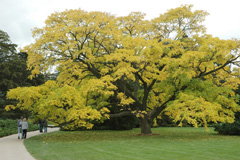

Humans have turned to trees to solve problems that nature has thrown at them since our prehistoric ancestors sheltered in trees. In modern times, indigenous people in the Meghalaya plateau of eastern India, create bridges from trees. In a mountainous region with deep ravines prone to extreme monsoonal flooding, reliable bridges are essential and these, made from the aerial roots of the Indian rubber tree, are strong and get even stronger as the trees grow over time. To see how they do this, check out this article. On this continent, some Native Americans used trees as markers to show the way to trails, burials, resources, or tribal lands. Young saplings were bent so that they would grow in a particular way that delivered a clear message to those that knew how to read them. To outsiders who did not know this language of trees, they seemed like any other tree, albeit a little quirky. Here is a man who has spent decades documenting these trees.
 |
Trees have also been the means by which people have been able to expand their resources and seek out better-living conditions. Take boats, for example: 10,000 years ago, someone used an ax to hack a canoe out of a Scotch pine tree. Known as the Pesse canoe, it is the oldest known boat and was found in the Netherlands. What were they after? Or what were they fleeing from? It’s an intriguing artifact. In the millennium since then, people have been taking to the water with help from trees. Ancient mariners traveled to Australia and throughout the Pacific islands. The Chinese built vessels during the Han dynasty (220 BC- 200 AD) and Romans built craft that enabled them to manage an expansive empire. The British were able to create an even larger empire, in part because they had plentiful forests to build their ships. And those ships ate up huge numbers of trees. Henry the VIII’s prized warship, the Mary Rose, required 600 oak trees to build in 1511. When you compare that to the 14 trees it took to build a Viking longship (also skilled sailors and colonizers), it is easy to see how the consumption of forest resources amped up over the centuries. As "new" lands and forests were populated (hello, America), the destruction of trees has continued unabated.
Humans are experts at exploiting forest resources; things could be vastly different if we recognized the spiritual side of trees as eagerly as we do the economic advantage of them. It’s hard to understand why this is as trees play a role in every major (and most minor) religion. In the Old Testament of the Bible, there are 328 references to trees and, in Genesis, God created trees before Man. In the Quran, Muslims are instructed to plant trees, to treat them with respect, and to recognize their spiritual essence. In Buddhist tradition, the Buddha gained enlightenment under a Bodhi tree. In Christianity, think of how Jesus’ crucifixion and everything that sprang from that would not have happened without that wooden cross. Animist beliefs, the essence of most indigenous religions, directly assigns spirituality to trees. This can be seen in Madagascar, where the awe-inspiring Baobab tree is believed to hold the spirits of ancestors. Across all these beliefs there are special trees, ones that are said to be miracle-makers, hold supernatural powers or cosmic secrets. In a time of great human divisiveness, we are bonded together in a spiritual connection to trees, whether we acknowledge it or not.
As I write this, trees are imperiled by bookend tragedies in the United States. Wildfires are decimating hundreds of thousands of acres in the Pacific Northwest and West and back-to-back hurricanes have sent untold thousands tumbling in southern states. Forest fires in Siberia have burned 42 million acres this year and the Amazon is burning. Given our close bond with trees, this devastation must be causing subliminal harm to the human psyche. Perhaps this (Covid-19 aside) is part of what is causing such angst in people. I fervently hope that people will become unhappy and uncomfortable enough to address the causes of such mass forest destruction and act to protect this glorious plant, in all its variations, that has meant so much to us.
 Stay tuned: my next few blogs will be about trees as well - there's just so much cool stuff to share!
Stay tuned: my next few blogs will be about trees as well - there's just so much cool stuff to share!Take care.
Submitted by Pam
Stay tuned: My next few blogs will be about trees as well - there's just so much cool stuff to share!
Take care.
Submitted by Pam








No comments:
Post a Comment